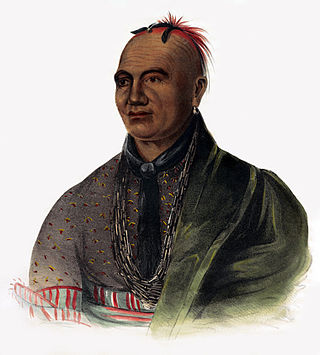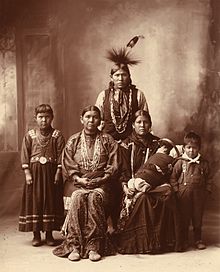
The Black Hawk War was a conflict between the United States and Native Americans led by Black Hawk, a Sauk leader. The war erupted after Black Hawk and a group of Sauks, Meskwakis (Fox), and Kickapoos, known as the "British Band", crossed the Mississippi River, to the U.S. state of Illinois, from Iowa Indian Territory in April 1832. Black Hawk's motives were ambiguous, but he was apparently hoping to reclaim land that was taken over by the United States in the disputed 1804 Treaty of St. Louis.

The Sac and Fox Nation is the largest of three federally recognized tribes of Sauk and Meskwaki (Fox) Indian peoples. Originally from the Lake Huron and Lake Michigan area, they were forcibly relocated to Oklahoma in the 1870s and are predominantly Sauk. The Sac and Fox Oklahoma Tribal Statistical Area (OTSA) is the land base in Oklahoma governed by the tribe.

Keokuk was a leader of the Sauk tribe in central North America, and for decades was one of the most recognized Native American leaders and noted for his accommodation with the U.S. government. Keokuk moved his tribe several times and always acted as an ardent friend of the Americans. His policies were contrary to fellow Sauk leader Black Hawk, who led part of their band to defeat in the Black Hawk War, was later returned by U.S. forces to Keokuk's custody, and who died a decade before Keokuk.

Black Hawk, born Ma-ka-tai-me-she-kia-kiak, was a Sauk leader and warrior who lived in what is now the Midwestern United States. Although he had inherited an important historic sacred bundle from his father, he was not a hereditary civil chief. Black Hawk earned his status as a war chief or captain by his actions: leading raiding and war parties as a young man and then a band of Sauk warriors during the Black Hawk War of 1832.

The Sauk River is a 122-mile-long (196 km) tributary of the Mississippi River in central Minnesota in the United States. It drains small lakes in Stearns County. In the Ojibwe language it is called Ozaagi-ziibi, meaning "River of the Sauks".

The Meskwaki, also known by the European exonyms Fox Indians or the Fox, are a Native American people. They have been closely linked to the Sauk people of the same language family. In the Meskwaki language, the Meskwaki call themselves Meshkwahkihaki, which means "the Red-Earths", related to their creation story.

The Black Hawk Purchase, also known as the Forty-Mile Strip or Scott's Purchase, extended along the West side of the Mississippi River from the north boundary of Missouri North to the Upper Iowa River in the northeast corner of Iowa. It was fifty miles wide at the ends, and forty in the middle, and is sometimes called the "Forty-Mile Strip". The land, originally owned by the Sauk, Meskwaki (Fox), and Ho-Chunk (Winnebago) Native American people, was acquired by treaty following their defeat by the United States in the Black Hawk War. After being defeated the Sauk and Meskwaki were forced to relinquish another 2.5 million hectares or and give up their rights to plant, hunt, or fish on the land. The purchase was made for $640,000 on September 21, 1832 and was named for the chief Black Hawk, who was held prisoner at the time the purchase was completed. The Black Hawk Purchase contained an area of 6 million acres (24,000 km²), and the price was equivalent to 11 cents/acre. The region is bounded on the East by the Mississippi River and includes Dubuque, Fort Madison, and present-day Davenport.

The Bad Axe Massacre was a massacre of Sauk (Sac) and Meskwaki (Fox) Native Americans by United States Army regulars and militia that occurred on August 1–2, 1832. This final scene of the Black Hawk War took place near present-day Victory, Wisconsin, in the United States. It marked the end of the war between white settlers and militia in Illinois and Michigan Territory, and the Sauk and Fox tribes under warrior Black Hawk.

Indigenous peoples of the Northeastern Woodlands include Native American tribes and First Nation bands residing in or originating from a cultural area encompassing the northeastern and Midwest United States and southeastern Canada. It is part of a broader grouping known as the Eastern Woodlands. The Northeastern Woodlands is divided into three major areas: the Coastal, Saint Lawrence Lowlands, and Great Lakes-Riverine zones.
The Dragoon Trace or Dragoon Trail is a historic trail that runs north and south through central Iowa and Missouri, including Ringgold County. It was originally made by the migration of animals, such as buffalo and deer. Because the Native Americans knew the animals had searched out the best place to cross the creeks and rivers, they too traveled this narrow path. Later used by the pioneers, this was the road to change Iowa's civilization.

Fort Armstrong (1816–1836), was one of a chain of western frontier defenses which the United States erected after the War of 1812. It was located at the foot of Rock Island, in the Mississippi River near the present-day Quad Cities of Illinois and Iowa. It was five miles from the principal Sauk and Meskwaki village on the Rock River in Illinois. Of stone and timber construction, 300 feet square, the fort was begun in May 1816 and completed the following year and consisted of three large blockhouses, like the replica, on its prominent corners. In 1832, the U.S. Army used the fort as a military headquarters during the Black Hawk War. It was normally garrisoned by two companies of United States Army regulars. With the pacification of the Indian threat in Illinois, the U.S. Government ceased operations at Fort Armstrong and the U.S. Army abandoned the frontier fort in 1836.

Antoine Le Claire was an American military interpreter, businessman, philanthropist, and principal founder of Davenport, Iowa.

Wabasha II, also known as Wapahasha, Wapasha, or "The Leaf," succeeded his father as head chief of the Mdewakanton Dakota tribe in the early 1800s. He led the Dakota forces fighting with the British in the War of 1812, but sided with the United States in the Black Hawk War of 1832. Chief Wabasha II signed the Treaties of Prairie du Chien in 1825 and 1830.
The Sac and Fox Reservation of Sauk (Sac) and Meskwaki (Fox) people is a 23.639 sq mi (61.226 km2) tract located in southeastern Richardson County, Nebraska, and northeastern Brown County, Kansas. It is governed by the Sac and Fox Nation of Missouri in Kansas and Nebraska, and the headquarters for reservation is in Reserve, Kansas. The tribal jurisdiction area is west of White Cloud, Kansas and northeast of Hiawatha, Kansas. It was created as a consequence of the Platte Purchase of 1836.

Quashquame was a Sauk chief; he was the principal signer of the 1804 treaty that ceded Sauk land to the United States government. He maintained two large villages of Sauk and Meskwaki in the early 19th century near the modern towns of Nauvoo, Illinois and Montrose, Iowa, and a village or camp in Cooper County, Missouri.

Several Native American tribes hold or have held territory within the lands that are now the state of Iowa.

The Sac and Fox Nation of Missouri in Kansas and Nebraska is one of three federally recognized Native American tribes of Sac and Meskwaki (Fox) peoples. Their name for themselves is Nemahahaki and they are an Algonquian people and Eastern Woodland culture.

The Sac and Fox Tribe of the Mississippi in Iowa is one of three federally recognized Native American tribes of Sac and Meskwaki (Fox) peoples in the United States. The Fox call themselves Meskwaki and because they are the dominant people in this tribe, it is also simply called the Meskwaki Nation. The Sauk people call themselves Êshkwîha or Yochikwîka, both with the meaning "Northern Sauk". They are Algonquian peoples, historically developed in the Eastern Woodland culture. The settlement, called Meskwakiinaki, is located in Tama County, Iowa.

The Treaty of St. Louis of 1804 was a treaty concluded by William Henry Harrison on behalf of the United States of America and five Sauk and Meskwaki chiefs led by Quashquame.
The New Purchase of 1842 is a treaty between the United States and the Sauk and Meskwaki tribes, referred to as the Sac and Fox in the treaty. The Native American tribes ceded land in Iowa west of the Mississippi River and north of the Missouri border.

















